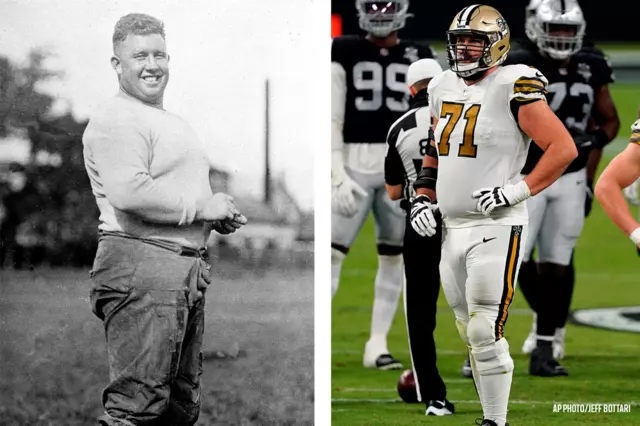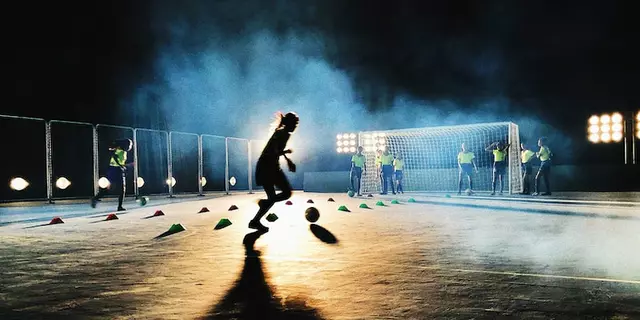A History of Football and Soccer: How Did the Two Sports Become Divided?
Football and soccer are two of the most popular sports in the world, and yet they both have distinct differences. While they may appear similar, the two sports took drastically different paths to become what they are today.
The earliest form of football was played in England in the 12th century. Initially, football was a violent and chaotic game with no clear rules or regulations. It was a game of brute strength and endurance, where the aim was to move an inflated leather ball by kicking, carrying, or throwing it across a field. It was the sport of choice for the working class, and it was seen as a rough and dangerous game.
In 1848, a group of English public school students wrote down the first set of football rules. This document, known as the Cambridge Rules, became the foundation for the modern game of football. It established the concept of dribbling, passing, shooting, and the offside rule, and it helped to make the game more orderly.
Meanwhile, soccer was evolving in the same period. The game was similar to football, but it was more focused on keeping the ball away from the opposition. This meant that the game was less physical and more tactical. Soccer teams would move the ball around the field in an attempt to score goals, and this strategy quickly proved successful.
The two sports diverged in 1863 when the Football Association (FA) was established in England. The FA declared that football should be played according to the Cambridge Rules, and it also decreed that the kicking of an opponent was forbidden. This led to the emergence of two distinct sports: football and soccer.
Since then, football and soccer have evolved in separate directions. Football has become more physical and focused on attacking play, and the rules have been refined to create the modern version of the game. Soccer, on the other hand, has become more technical, with teams looking to maintain possession and create chances.
The two sports are now vastly different, but their common history can still be seen in their similarities. The roots of both football and soccer can be traced back to the same place, and this shared history has helped to create two of the most popular sports in the world.
Exploring the Origins of Football and Soccer: Why the Split?
Football and soccer were two games that were once the same. Where did the split occur? How did two sports, once unified, become two distinct games? To understand why football and soccer are now two separate sports, we need to explore the origins of both games and the events that led to their divergence.
The Roots of Football and Soccer
Both football and soccer have origins that date back to ancient civilizations. The Chinese game of cuju was a popular ball game played as far back as the 2nd and 3rd centuries BC. In Europe, a game called Harpastum was a similar game to cuju that was popular in the Roman Empire during the 1st century BC. These games were similar to modern-day football and soccer in their basic premise, but the rules varied greatly.
The Development of Football and Soccer
During the Middle Ages, football was a popular game in Europe. Different versions of the game were played in different countries, but the rules were similar enough that it was essentially the same game. Eventually, the game of football became codified in England, and the Football Association was formed in 1863. This was the first step in football becoming a sport with uniform rules and regulations.
Soccer, on the other hand, was a game that developed from the same roots as football but with different rules. The first set of soccer rules was developed in 1848 by a school in England. The rules were similar to those of football, but they were designed to be less violent and more accessible to a wider range of people. This led to the formation of the Football Association in 1863, which was the first step in soccer becoming a sport with uniform rules and regulations.
The Split of Football and Soccer
The split between football and soccer occurred in the late 19th century. The Football Association in England decided to codify their own rules, which allowed for more physical contact and a greater emphasis on attacking play. This led to a divergence between the two games, as many teams preferred the more physical football game. This led to the creation of two distinct sports: football and soccer.
Conclusion
The split between football and soccer occurred due to the codification of rules by the Football Association in England. The rules that were developed allowed for more physical contact and a greater emphasis on attacking play, which led to a divergence between the two games. As a result, the two sports became distinct, with football and soccer becoming two separate sports.
The Great Divide: How Football and Soccer Differ in Rules and Mechanics
Football and soccer are two of the most popular sports in the world, but do you know what makes each unique? The rules and mechanics of each sport are drastically different, and understanding those differences is key to appreciating the game. Let's take a look at the great divide between football and soccer so you can understand the nuances of each.
The Field & Equipment
The playing field for soccer is much larger than that of football. Soccer fields measure between 50 and 100 yards in length, and between 100 and 130 yards in width. Football fields measure 100 yards in length, and 53.3 yards in width. The end zones for football fields are also 10 yards deep, making for a total field size of 120 yards long and 53.3 yards wide. Soccer fields are not marked with end zones.
In terms of equipment, soccer players wear shorts, cleats, a jersey, and shin guards. The ball is a round, inflated sphere. Football players wear helmets, shoulder pads, pads on their thighs, hips and knees, as well as cleats. The ball is a prolate spheroid, and is longer and more pointed than a soccer ball.
Number of Players
Soccer is played by two teams of 11 players each, while football is played by two teams of 11 players each. Soccer teams are typically composed of one goalkeeper, four defenders, four midfielders, and two forwards. Football teams are composed of one quarterback, five offensive linemen, four wide receivers, two running backs, one tight end, and five defensive linemen.
Scoring
The main objective of both soccer and football is to score points by getting the ball into the opposing team's goal. In soccer, the ball must cross the goal line, while in football, the ball must reach the end zone or be kicked through the uprights. In soccer, a goal is worth one point, while in football, a touchdown is worth six points.
Rules & Regulations
The rules and regulations of soccer and football are vastly different. In soccer, players are allowed to use any part of their body to move the ball, but they are not allowed to touch the ball with their hands or arms. In football, players are allowed to use their hands and arms to move the ball, but they are not allowed to use their feet. In soccer, players cannot tackle or block, while in football, players can tackle and block.
In soccer, the referee stops the game when a foul is committed, while in football, the referee continues to allow play until the ball is dead. In soccer, a player is only allowed to be substituted off once during a game, while in football, a team can make unlimited substitutions. The rules and regulations of each sport are designed to make them both unique and exciting.
The Evolution of Football and Soccer: How the Split Changed the Game
Football and soccer have been two of the most popular sports across the globe for centuries. While the two sports have a few similarities, they are in fact very different in terms of their rules, regulations and the way they are played. But how did these two popular sports split and evolve over time?
The Origins of Football and Soccer
The history of football and soccer can be traced back to ancient civilizations, with the earliest evidence of a ball game being found in China in 2,000 BC. This early version of the game was known as ‘cuju’ and involved a leather ball being kicked into a small net. In the Middle Ages, a similar game called ‘harpastum’ was popular in Rome, while in England, ‘mob football’ was played on Shrove Tuesday.
By the 19th century, football had evolved into a game with two teams of 11 players and a goal at each end of the pitch. The modern rules of the game were first established in 1863, when the Football Association was formed in London. Soccer, on the other hand, was a variant of football that had been developed in Scotland in the late 19th century.
The Split of Football and Soccer
The split of football and soccer happened in the 1880s, when the Football Association banned the use of hands in the game. This ‘hands-free’ version of the game was known as ‘association football’, while the version of the game that allowed the use of hands was known as ‘rugby football’. As a result, the two sports began to evolve down different paths.
In the early 20th century, the two sports were further divided when the International Football Association Board (IFAB) was established in 1904. The IFAB is an international body that is responsible for the laws of the game, and it declared that only ‘association football’ could be called ‘football’.
The Impact of the Split
The split of football and soccer had a huge impact on the two sports, and on the world of football in general. The popularity of football and soccer continued to grow, but the two sports developed along very different paths. Football shifted its focus to the use of hands, while soccer retained its focus on the use of feet. This difference has become an integral part of the two sports, and it has helped to define the way they are played.
The split of football and soccer also had an impact on the tactics and strategies used by teams. In football, teams tend to focus on passing the ball around and working together to create chances, while in soccer, teams tend to focus on individual skill and dribbling. This has led to two very different approaches to the game, and it has helped to make football and soccer two of the most popular sports in the world.
A Deeper Look at the Split: Examining the History and Impact of Football and Soccer Separating
Football and soccer have had a long and intertwined history, with the two sports often being considered the same until the late 19th century. However, despite the fact that the two sports have their roots in the same game, they have grown to become two distinct sports with their own unique histories and cultures. In this article, we will take a deeper look at how football and soccer split and the impact this split has had on each sport.
The Origin of Football and Soccer
Football and soccer both have their roots in the same sport, which was played in medieval times. This game was known as “folk football” and involved teams of people from different villages kicking a ball around a large field. It was a popular sport, and it was played across Europe, with different regions having their own rules and regulations.
Over time, the game began to evolve, and by the 19th century, it had developed into two distinct sports – football and soccer. Football was the more physical of the two, and it was played with rules that allowed for physical contact between the players. Soccer, on the other hand, was designed to be a more technical, non-contact sport.
The Split Between Football and Soccer
The split between football and soccer began in 1863, when the Football Association (FA) was formed in England. The FA wanted to create a set of rules that would make football more organized and easier to play. These rules did not allow for physical contact, making it more of a soccer-like game than the traditional folk football.
The split between football and soccer was further emphasized in 1871, when the first international match was held between Scotland and England. This was the first time that two countries had ever played each other under the same set of rules, and it was a clear sign that football and soccer were now two distinct sports.
The Impact of the Split
The split between football and soccer has had a significant impact on both sports. Football has grown to become a physical, contact-based sport with a high level of excitement and entertainment, while soccer has evolved into a more technical, non-contact game with a greater emphasis on strategy and technique. This has led to the two sports becoming more popular in different parts of the world, with football being more popular in Europe, South America, and North America, and soccer being more popular in Asia, Africa, and Oceania.
The split between football and soccer has also had an impact on how the two sports are viewed by the public. Football is often seen as a more violent sport, while soccer is seen as a more peaceful and friendly game. This has led to football often being seen as a more masculine sport, while soccer is seen as a more feminine sport.
Conclusion
Football and soccer have come a long way since their split in the 19th century. Today, the two sports are very distinct and have their own unique histories and cultures. The split between football and soccer has had a significant impact on both sports, and it has changed the way the two sports are viewed by the public. It is clear that the split between football and soccer is an important part of their history, and it has had a profound impact on each sport.








Write a comment